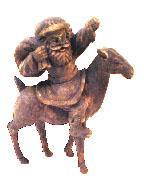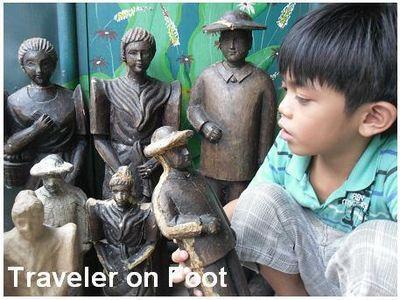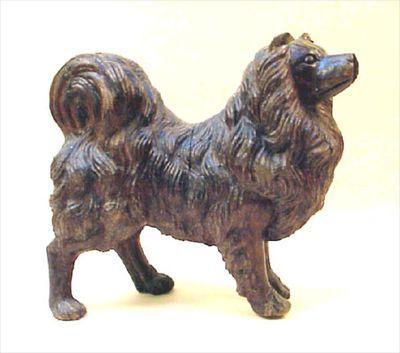
Photo and all text via: The Art of the Taakan by Gene and Linda Kangas and Nicholas Kondon via Creekside Art Gallery. For more information following this link: http://creeksideartgallery.com/articles/art_of_takaan.html
"In the Philippines, specifically in the town of Paete in Laguna Province, the multiple production of paper mache objects first required the hand carving of hardwood sculptures. These became the positive wooden molds that were coated with wax release agents. Then pieces of paper soaked in natural rice starch were laid upon the forms and dried. Once dry, the tough paper shells which mirrored each woodcarving were cut away with sharp blades. The front and rear halves were peeled off and re- joined. Seams were papered over and the hollow, light-weight paper mache castings were then embellished and protected with paint and gilding. The process was repeated again and again. When paper mache artisans completed their orders, the carvings were retired."
"One easy way to identify authentic paper mache molds is to look for the visual evidence of tiny knife slits which, through extensive use, wore down and scarred surfaces. These are found particularly along ears, arms, tops of heads and around the "foot" of the patterns. Any light-colored remnants remaining within the cut marks are traces of paper mache. Because of repeated coatings of pigmented waxes, molds often developed a rich warm patina; the tonal quality of the wax helped produce surfaces resembling mahogany, walnut, and other hard woods."

Photo and all text via: The Art of the Taakan by Gene and Linda Kangas and Nicholas Kondon via Creekside Art Gallery. For more information following this link: http://creeksideartgallery.com/articles/art_of_takaan.html
"Many of the original molds for these were created in the beginning of the 1930s. However, local oral history recalls that the first takas were made earlier, in the 1920s by Maria Bague for her family's own use. Another person remembered that:
"Each year Paete and neighboring towns held festivals that were well attended. Someone from Paete got the idea that they could cover carvings with paper mache and then take the paper figures to the festivals to sell. Everyone needed money and the novel idea proved to be popular. All of the paper mache images sold and that was the beginning of the paper mache cottage industry in Paete."

"For several years religious figures and a few animals were the primary things made and sold until festival visitors began requesting additional images. "Do you make dogs or cats?" They asked. "How about other animals or people?" Soon a wide variety of paper mache forms were being fashioned and marketed. Horses were one of the earliest and most popular; they have become classics. Few still exist. The facade of Saint James Church has an old relief stone carving of Santiago (Saint James) astride a horse. Of course, horses and the others were being shaped over takaans carved just for that purpose. Sometime in the 1930s many images other than religious figures could be found among the wooden paper mache molds in storage."

Photo and all text via: The Art of the Taakan by Gene and Linda Kangas and Nicholas Kondon via Creekside Art Gallery. For more information following this link: http://creeksideartgallery.com/articles/art_of_takaan.html
"Soon European and American visitors began requesting that certain things be carved and paper mache be made for important holidays or larger department stores. While some were to be used as seasonal decorations, many were to be sold. Thus the popularization of paper mache spread from our small village to many countries throughout the world."
Source of the above text via:
Photo and all text via: The Art of the Taakan by Gene and Linda Kangas and Nicholas Kondon via Creekside Art Gallery. For more information following this link: http://creeksideartgallery.com/articles/art_of_takaan.html
The winners: Martina, first guess that it was a mold, and then Molly guessed it was a paper mache mold, and finally Sally from Dovetail Antiques guessed it. I would like to send all three of you a gift. Please contact me by email with your address.
The most creative answer was Julie Vintage with Laces: "These wooden animals come from Asia. Restaurants put them in their windows to show what kind of meat they serve. Besides chickens and cows, there also dogs, snakes, crickets, spiders, rats and some others available. Bon appetit!"
On another note I am asking Karen the author of:
A Culinary Legacy From Escoffier to Today.
to pick the winner of her cookbook. details to come.








COMMENTS ( 1 )
posted on 21 August at 19:06
Howdy very nice website!! Man .. Beautiful .. Wonderful .. I will bookmark your site and take the feeds also? I am happy to search out a lot of useful info here within the submit, we want work out more techniques in this regard, thanks for sharing. . . . . .